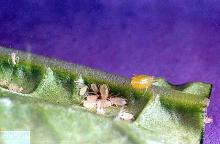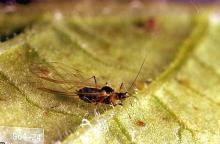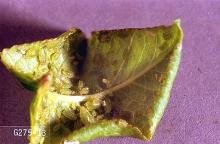Includes
Artichoke aphid (Capitophorous elaeagni)
Erigeron root aphid (Aphis middletonii)
Green peach aphid (Myzus persicae)
Thistle aphid (Brachycaudus cardui)
Pest description and crop damage Artichoke aphids are pale, almost translucent aphids with distinctly dusky-colored cornicles and diverging tubercles at the base of the antennae. Thistle aphids are small yellow or green plant lice. The upper surface of the abdomen of the adult B. cardui is black. Adults with black crossbars on the abdomen are A. middletonii. The green peach aphid is slender, dark green to yellow, with converging tubercles and no waxy bloom. It is primarily an early-year pest. Aphid infestations may result in wilting, leaf curling, weakened bud stalks, and slowed growth.
Biology and life history
See:
Common Pests of Vegetable Crops
Pest monitoring Check fields frequently during the early growing year and after seedling emergence in annual artichoke plantings. If aphids become numerous, increase frequency of sampling. Aphids often are concentrated in hot spots or near the field margin. Note the presence of any hot spots, but avoid sampling only those areas. Also, be sure to look for evidence of biological control; i.e., the presence of predators, parasitoids (aphid mummies), and pathogens. Aphid flights are most common during periods of moderate temperatures (60° to 80°F). Monitor fields particularly closely during April and May. Green peach aphids may move into fields early in the year. They do not transmit significant viruses to artichokes, and they rarely require treatment. Early year aphids have many natural enemies.
Management-biological control
Many parasitoids and predators attack aphids. Among the more common predators are lady beetles and their larvae, lacewing larvae, and syrphid fly larvae. Populations of green peach aphids are reduced in winter by the insect pathogenic fungus Entomophthora aphidis. Monitor the proportion of aphid mummies (fungus-killed aphids) relative to healthy aphids and the numbers of predators such as lady beetles. If the proportion of mummies is increasing, or predators appear to be gaining control, and aphid populations are not yet damaging, avoid sprays that will disrupt these natural enemies. Most materials available for aphid control are highly disruptive of natural enemy populations.
Management-cultural control
Destroy infested crops immediately after harvest to prevent dispersal. Destroying weed hosts, especially thistles, late in the year may help destroy overwintering populations. Aphid populations tend to be higher in crops that are fertilized liberally with nitrogen.
Home gardeners can often get effective control by washing aphids with a strong stream of water.
Management-chemical control: HOME USE
Apply to both tops and undersides of leaves.
- azadirachtin (neem extract)-Some formulations are OMRI-listed for organic use.
- bifenthrin
- deltamethrin
- esfenvalerate
- insecticidal soap-May require several applications. Some formulations are OMRI-listed for organic use.
- plant-derived essential oils (peppermint, rosemary oil, etc.)-Some formulations are OMRI-listed for organic use.
- pyrethrins (often combined with other ingredients)-Some formulations are OMRI-listed for organic use.
Management-chemical control: COMMERCIAL USE
- Beauveria bassiana (Mycotrol ESO) at 0.25 to 1 quart/A. PHI 0 days. REI 4 hr. OMRI-listed for organic use.
- bifenthrin/imidacloprid (Brigadier) at 0.1 to 0.2 lb ai/A. PHI 7 days. REI 12 hr. Do not exceed 0.5 lb ai/A imidacloprid and 0.5 lb ai/A bifenthrin. Retreatment interval 15 days.
- Chromobacterium subtsugae (Grandevo) at 0.6 to 0.9 lb ai/A per 100 gal. PHI 0 days. REI 4 hr. OMRI-listed for organic use.
- imidacloprid (Admire Pro) at 0.25 to 0.5 lb ai/A soil application in furrow or chemigation or at 0.05 to 0.125 lb ai/A foliar. REI 12 hr. PHI 7 days. Retreatment interval 14 days. Do not exceed 0.5 lb ai/A per season.
- insecticidal soap (M-Pede) at 1 to 2% solution. Potassium salts of fatty acids. See label for gal/A. PHI 0 days. REI 12 hr. Some formulations are OMRI-listed for organic use.
- spirotetramat (Movento) at 0.08 to 0.13 lb ai/A. PHI 3 days. REI 24 hr. Retreatment interval 7 days. Do not exceed 0.5 lb ai/A per season.
- thiamethoxam (Actara) at 0.047 lb ai/A. PHI 4 days. REI 12 hr. Retreatment interval 7 days. Do not exceed 0.094 lb ai/A per season. Washington only.
These products contain commonly used active ingredients for control of leafhopper in parsnip. There are other materials available. Please consult a licensed crop advisor for additional recommendations.




